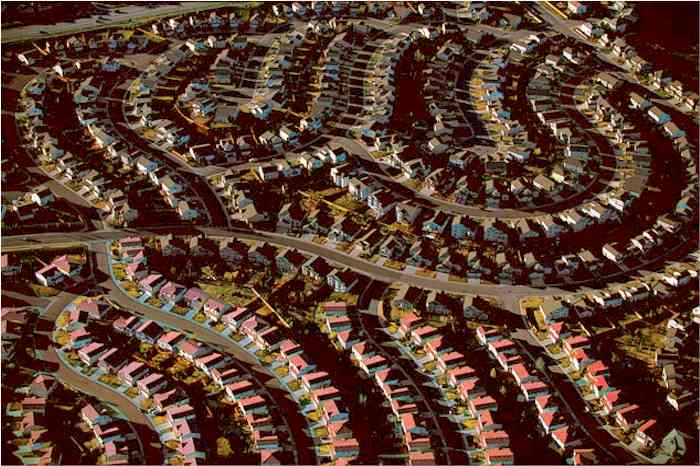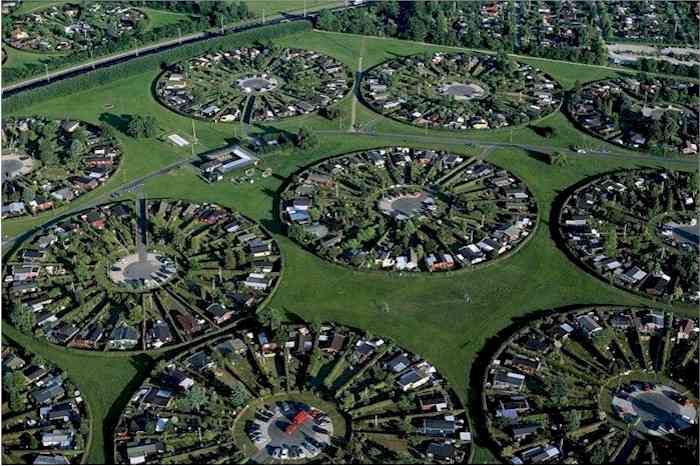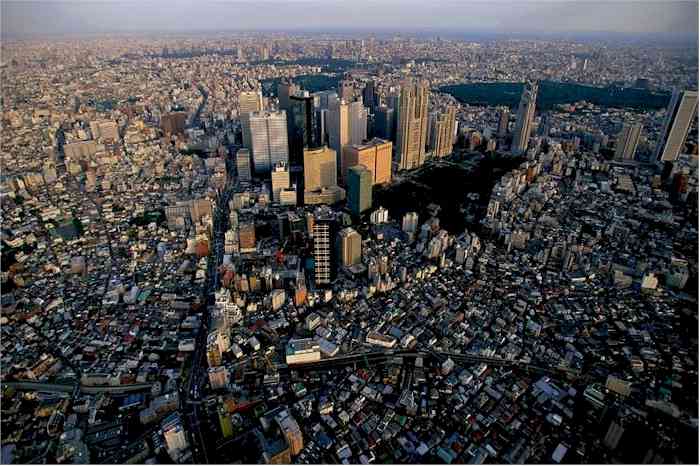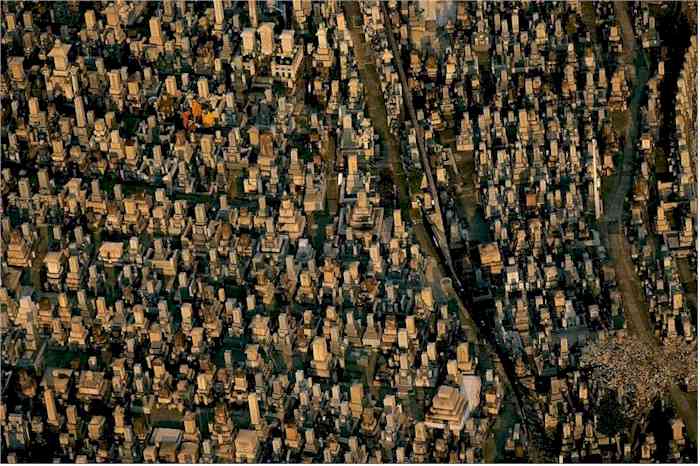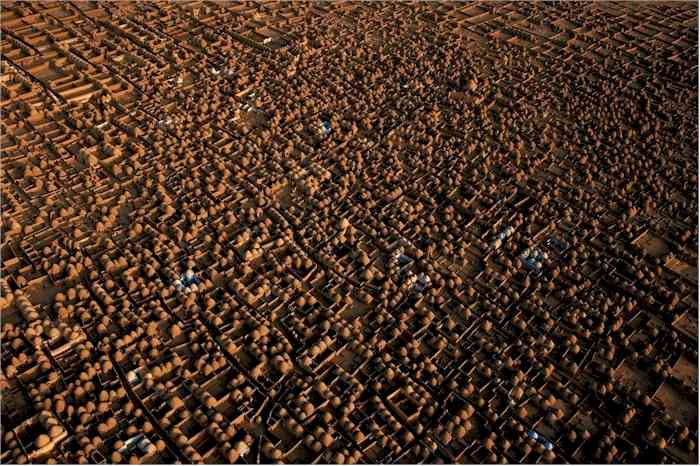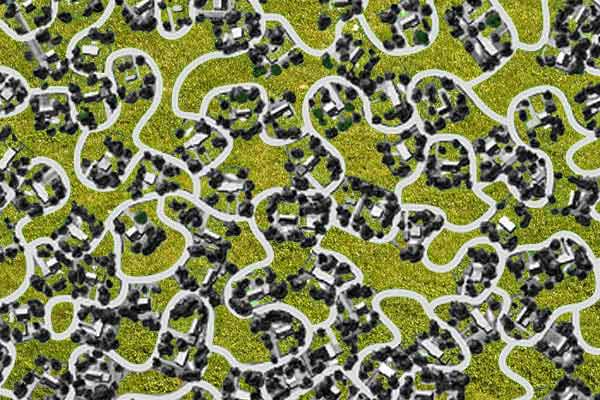The Monotony of High Density
So No Place to Live Is Really Okay (Even If You're Dead)?Suburbs have become the heirs to their cities' problems. - Charles Haar The immense cities lie basking on the beaches of the continent like whales that have taken to the land. - Arnold J Toynbee
Highlands Ranch, Outskirts of Denver, Colorado, United States (39°44' N, 104°59' W) These winding streets of identical houses do nothing to break up the monotony of the asphalt. The outskirts of Denver are a good example of the runaway sprawl of suburbs in North America. This phenomenon was triggered by postwar economic growth, which encouraged private home ownership and stimulated investment in roads. Since then, the number of people living in such areas has relentlessly grown - by 12% between 1990 and 1998 - at the expense of the growth of city centres, at a rate of 4.7% over the same period. These networks of low-density suburbs make their residents totally dependent on their cars, one of the chief sources of greenhouse gases. This dependence is one reason that Americans generate the highest emissions of greenhouse gases on the planet. Although North Americans are only 5% of the world’s population, in 1998, they produced almost a quarter of human-generated carbon dioxide. Source: yannarthusbertrand.com from Earth from Above by the incomparable photographer Yann Arthus-Bertrand
Okay. I can't quibble with the sentiments, but I do have to wonder why this Denver suburb was picked as a good example of being bad - at least the streets have a curve to them instead of being unimaginatively rectangular blocks. And what would make a better suburb? This, I suspect would be a step in the right direction...
Housing plots at Brøndby, on the outskirts of Copenhagen, Seeland, Denmark (55°34' N, 12°23' E) To combine management of the available space with security and comfort, the building plots at Brøndby, on Copenhagen’s southwestern fringe, are arranged in perfect circles, in which each holder has a lot of 4,305 square feet (400 m2). This type of residential district, which is highly practical, is increasingly common on the outskirts of large cities where there are many jobs. The growth of industry, the attraction exerted by cities, and the expansion of large metroplexes have led to a 13% increase in the world’s city-dwellers — a trend that is continuing. Almost half the planet’s population, 45%, is now urban. By 2025, there will be 25 giant metroplexes — megalopolises — in the world, each home to between 7 million and 25 million people. Three-quarters of the other billion city dwellers the planet will accommodate in 2025 will live in southern countries. Source: yannarthusbertrand.com from Earth from Above by the incomparable photographer Yann Arthus-Bertrand
Still, suburbs, even green ones, tend to require cars (unless mass transportation is both available and widely accepted). Living in a city means you could do without a car - but then you might find yourself trying to raise children in an environment like this - would this be "better"?
Shinjuku district of Tokyo, Japan (35°42' N, 139°46' E) In 1868 Edo, originally a fishing village built in the middle of a swamp, became Tokyo, the capital of the East. The city was devastated by an earthquake in 1923 and by bombing in 1945, both times to be reborn from the ashes. Extending over 43 miles (70 km) and holding a population of 28 million, the megalopolis of Tokyo (including surrounding areas such as Yokohama, Kawasaki, and Chiba) is today the largest metropolitan region in the world. It was not built according to an inclusive urban design and thus contains several centres, from which radiate different districts. Shinjuku, the business district, is predominantly made up of an impressive group of administrative buildings, including the city hall, a 798-foot-high (243 m) structure that was modelled after the cathedral of Notre Dame in Paris. In 1800 only London had more than 1 million inhabitants; today 326 urban areas have reached that number, including 180 in developing countries and 16 megalopolises that have more than 10 million each. Urbanisation has led to a tripling of the population living in cities since 1950. Source: yannarthusbertrand.com from Earth from Above, by the incomparable photographer Yann Arthus-Bertrand
The heat and pollution generated by megalopolises is staggering. From space, the look something like barnacles. But it isn't only the living who take up space and occupy cities that radiate heat...
Cemetery in Kyoto, Honshu, Japan (N 35°00'-E 135°45') Both through their view of suicide and through their funerary rites, the Japanese have made a true ritual out of death. In their eyes, “determined death” follows the code of honour and loyalty espoused by the samurai warriors, of whom kamikaze pilots were a recent example. Japanese funeral rites are governed by a range of rules and traditions, from the direction in which the burial vault and the deceased should face (northward) to the organisation of the funeral itself, of the meal that follows it, and the use of salt to purify the mourners. Cremation is widespread among Buddhists, and is accompanied by various rites such as picking out the bones from the ashes using two rods of unequal length and leaving them on the domestic altar for longer than a month before burial at the cemetery. This interest in death is matched by an equal lust for life, for the Japanese live longer on average than almost anyone else in the world: the women 83 years, the men 78. Source: yannarthusbertrand.com from Earth from Above by the incomparable photographer Yann Arthus-Bertrand
Sometimes the living and the dead share the same space...
Modern graves in a cemetery at Asyut, Nile valley, Egypt (27°11' N, 31°11' E) The idea of eternal life, so dear to the ancient Egyptians, is conveyed through a style of funerary architecture that stands the test of time. These tombs are divided into two sections, one representing the life of the deceased and the other containing the person’s remains and the objects customarily regarded as making life in the hereafter more pleasant. The world of the living coexists with that of the dead, and cemeteries are close to towns. An Egyptian city of the dead can stretch over several miles (or kilometres) and is laid out like a town, with a rich variety of open spaces and architecture. With the passage of time, the commingling of the worlds of the living and the dead becomes more obvious. A combination of deregulation of the rental market, a serious shortage of social housing, and evictions, with no system for compensation or finding alternative accommodation, have driven some people to live in cemeteries. In Cairo, a megalopolis of 16 million people, the famous City of the Dead is thought to accommodate between 500,000 and 1 million underprivileged people — at least 20,000 of whom are living in the tombs themselves. Source: yannarthusbertrand.com from "Earth from Above" by the incomparable photographer Yann Arthus-Bertrand For more aerial photographs of dense civilisation, see also (all in the Money Politics/How Many Countries in the World section):
A Fantastic(al) Place...
"Goldenwood Shores" by Ross Racine, 2009 Drawn freehand directly on a computer and printed on an inkjet printer, his works do not contain photographs or scanned material. The subjects of his recent work may be interpreted as models for planned communities as much as aerial views of fictional suburbs, referring to the dual role of the computer as a tool for urban planning as well as image capture. Examining the relation between design and actual lived experience, the works subvert the apparent rationality of urban design, exposing conflicts that lurk beneath the surface. Beyond the suburban example, his digital drawings are a way of thinking about design, the city and society as a whole. Source: rossracine.com
For pages on natural disasters - including tornados, hurricanes, volcanoes, floods, global warming and more - as well as satellite photos and some great pictures of trees, clicking the "Up" button
immediately below takes you to the Index page for this Environment section. |
 Animals
Animals Animation
Animation Art of Playing Cards
Art of Playing Cards Drugs
Drugs Education
Education Environment
Environment Flying
Flying History
History Humour
Humour Immigration
Immigration Info/Tech
Info/Tech Intellectual/Entertaining
Intellectual/Entertaining Lifestyles
Lifestyles Men
Men Money/Politics/Law
Money/Politics/Law New Jersey
New Jersey Odds and Oddities
Odds and Oddities Older & Under
Older & Under Photography
Photography Prisons
Prisons Relationships
Relationships Science
Science Social/Cultural
Social/Cultural Terrorism
Terrorism Wellington
Wellington Working
Working Zero Return Investment
Zero Return Investment